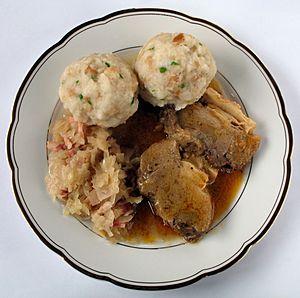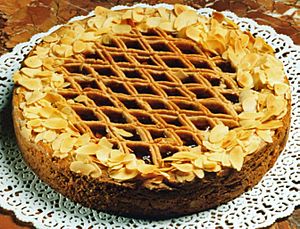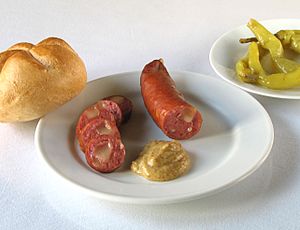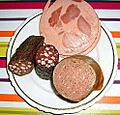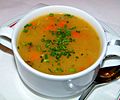Austrian cuisine facts for kids
Austrian cuisine (called Österreichische Küche in German) is the traditional food style of Austria. It mixes ideas from Central Europe and the old Austro-Hungarian Empire. When people think of Austrian food, they often think of Viennese cuisine, which comes from the capital city, Vienna. But different parts of Austria have their own special dishes too!

Contents
Mealtimes
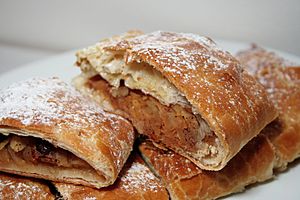
For breakfast, Austrians usually have bread rolls with jam, or cold meats and cheese. They often drink coffee, tea, or juice. Long ago, lunch was the biggest meal of the day. But now, many Austrians eat their main meal in the evening because of work.
Sometimes, people have a snack in the morning or afternoon called a Jause. It's usually a slice of bread with cheese or ham. A bigger snack, like a "ploughman's lunch" in Britain, is called a Brettljause. It gets its name because it's served on a wooden board.
Popular Dishes of Vienna
Vienna has many famous dishes. Here are some you might find:
- Rindsuppe: This is a clear, golden beef soup.
- Tafelspitz: Boiled beef served with sauces like apple and horseradish.
- Gulasch (goulash): A hearty stew, similar to a Hungarian dish. It's often eaten with bread or dumplings.
- Liptauer: A spicy cheese spread, usually eaten on bread.
- Selchfleisch: Smoked and cooked meat, served with Sauerkraut (sour cabbage) and dumplings.
- Powidl: A thick, sweet jam made from plums.
- Apfelstrudel: A famous pastry with layers of thin dough and an apple filling.
- Topfenstrudel: A strudel filled with cream cheese.
- Palatschinken: Thin pancakes, like French crêpes. They can be filled with jam or even spinach and cheese.
- Kaiserschmarrn: A fluffy pancake that's ripped into pieces and lightly roasted. It's often served with fruit compote.
- Germknödel: A soft, fluffy dumpling made from yeast dough. It's filled with plum jam and topped with poppy seeds and powdered sugar.
- Marillenknödel: A dumpling filled with an apricot, covered in sweet crumbs and powdered sugar.
- Saftgulasch: A juicy beef stew, a special Austrian version of goulash. It's cooked slowly with lots of onions until the beef is very tender.
- Wurstsemmel: Basically, a bread roll filled with ham or sausage.
- Krautfleisch: A stew made from pork and Sauerkraut.
- Krautspatzle: A dish with small noodles (spatzle) and cabbage.
Meat
The most popular meats in Austria are beef, pork, chicken, turkey, and goose. The famous Wiener Schnitzel is traditionally made from veal (meat from young cows). Pork is used a lot, even parts like the snout.
Austrian butchers have special ways of cutting meat. For example, Tafelspitz is a special cut of beef. Fledermaus (which means "bat" in German) is a cut of pork that looks like a bat. It's very juicy and good for slow cooking.
Austria has many different sausages. Some popular ones are Frankfurter, Krainer Wurst, and Debreziner. Speck is the Austrian word for bacon. It can be smoked, raw, or spiced, and is used to add flavor to many dishes. Leberkäse is a loaf made from corned beef, pork, and bacon. Even though its name sounds like "liver cheese," it has neither!
Game
Austria has a long history of hunting because it has many forests. In autumn, many restaurants offer game meat on their menus. They serve it with seasonal vegetables and fruits. Common game animals include:
- Deer (called "Hirsch" or "Reh")
- Wild Boar ("Wildschwein")
- Brown hare ("Hase")
- Common pheasant ("Fasan")
- Duck ("Ente")
When you see "-braten" after an animal's name, it means roast game. For example, Hirschbraten is roast venison (deer meat).
Sweets
Cakes
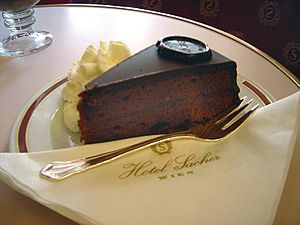
Austrian cakes and pastries are very famous. The most well-known is the Sachertorte. It's a chocolate cake with apricot jam inside, usually eaten with whipped cream. Another old and famous cake is the Linzer torte. Other favorites include the caramel-flavored Dobostorte and the layered Esterhazy Torte. These cakes came from Hungary when it was part of the Austro-Hungarian Empire.
Punschkrapfen is a classic Austrian pastry filled with cake crumbs, chocolate, and apricot jam, soaked in rum. Tirolerkuchen is a hazelnut and chocolate coffee cake. These cakes are often complex and take skill to make. You can enjoy them at a café or buy a slice from a bakery. A "Konditorei" is a special cake shop.
Desserts
Austrian desserts are usually a bit simpler than the fancy cakes. The most famous is the Apfelstrudel (apple strudel). It has thin layers of pastry around an apple filling, often with cinnamon and raisins. Other strudels are also popular, like those filled with sweetened cheese (Topfenstrudel) or poppy seeds (Mohnstrudel).
Another favorite is Kaiserschmarr'n, a rich, fluffy, sweet pancake with raisins. It's broken into pieces and served with fruit compote, usually made from plums. A special dessert from Salzburg is the meringue-like "Salzburger Nocken." The Danish pastry is said to have come from Vienna. In Denmark, it's even called wienerbrød, meaning "Viennese bread."
Drinks
Coffee

Many people believe that coffee came to Europe through Austria after the Battle of Vienna in 1683. While coffeehouses existed before, the Viennese café tradition became a very important part of the city.
Coffee is served in many ways, especially in Viennese coffee houses. An Austrian Mokka is like an espresso, but made slower. Other styles are made from the Mokka:
- kleiner Brauner or großer Brauner: A single or double Mokka with milk.
- Melange: Half Mokka, half hot milk, often with foamed milk on top.
- Einspänner: A large Mokka topped with whipped cream.
- Wiener Eiskaffee: Iced Mokka with vanilla ice cream and whipped cream.
Italian styles like cappuccino and espresso are also common. Coffee is traditionally served with a glass of still water.
Drinking coffee together is a big part of Austrian social life. Austrians often invite friends over for coffee and cake. It's also very common to go to a coffeehouse when meeting someone.
Hot Chocolate
Viennese hot chocolate is very rich. It often contains heavy cream and sometimes even egg yolk, making it extra thick and creamy.
Soft Drinks
Almdudler is an Austrian soft drink made from mountain herbs. It tastes a bit like elderberry. It's sometimes called the "national drink of Austria." It's also popular to mix it with white wine or water. While Red Bull is popular worldwide, this energy drink company actually started in Austria! Its main office is near Salzburg.
Beer and Wine
Austria is known for its beer and wine. Beer is usually sold in different sizes, like 0.2, 0.33, or 0.5 liters. Popular types include pale lager and wheat beer.
Wine is mostly made in the east of Austria. Important wine areas are in Lower Austria, Burgenland, Styria, and Vienna. The Grüner Veltliner grape makes some of Austria's best white wines. Zweigelt is a common red wine grape. Wine is even grown inside the city of Vienna, which is unique for a European capital!
Young wine from the newest harvest is called Heuriger. This name is also used for special inns in Vienna that serve this wine with food.
Snack Food
For snacks between meals, there are many types of open sandwiches called "belegte Brote." You can also find different kinds of sausage with mustard, ketchup, and bread. Sliced sausage, Leberkäse rolls, or Schnitzelsemmeln (rolls with schnitzel) are also popular.
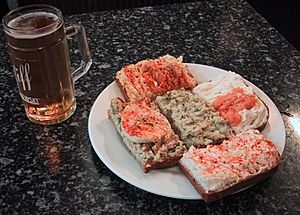
You can often get a Wurstsemmel (a roll filled with thinly sliced sausage, cheese, and a pickle) at a butcher shop or supermarket.
Other popular informal snacks include the Bosna or Bosner. This is a spiced sausage in a hot dog roll, often found at Austrian fast-food stands called Würstelstand. Most Austrian sausages contain pork.
Regional Cuisine
Lower Austria
In Lower Austria, you'll find special local foods like poppies from Waldviertel, asparagus from Marchfeld, and Wachau apricots. The "Marillenknödel" (apricot dumplings) are famous here. Game dishes are also very common. Lower Austria has many different regional foods because it's a large area with varied landscapes.
Burgenland
Burgenland's food has been influenced by Hungarian cuisine because it used to be part of Hungary. Dishes often feature fish, chicken, or pork. Potatoes are a common side dish, like "Greste Krumpian" (roasted potatoes with onions). Because of the Hungarian influence, Burgenland dishes are often spicier than in other parts of Austria. On St Martin's Day (November 11), a Martinigans (St Martin's goose) is often prepared. Carp is a typical Christmas dish.
Styria
In Styria, you might find Verhackertes, a spread made from finely chopped raw bacon. Schilcher, a very dry rosé, is a special wine from Western Styria. A unique Styrian food is pumpkin seed oil, which tastes nutty and is great for salads. Many dishes made with pumpkin are also popular. Heidensterz, a dry dish made from buckwheat flour, is eaten in cold weather. Game dishes are very common, especially in autumn.
Carinthia
Carinthia has many lakes, so fish is a popular main course. Grains, dairy products, and meat are important in Carinthian cooking. Carinthian Kasnudeln (noodle pockets filled with quark cheese and mint) and Schlickkrapfen (usually with meat filling) are well-known local foods. Reindling (a yeast-dough cake filled with cinnamon, sugar, walnuts, and raisins) is also made here.
Upper Austria
Different types of dumplings are a big part of Upper Austrian food, similar to nearby Bavaria. Linzer Torte, a cake with ground almonds or nuts and redcurrant jam, is a popular dessert from Linz, the capital of Upper Austria. Linzeraugen are soft biscuits filled with redcurrant jam.
Salzburg
Kasnocken (cheese dumplings) are a popular meal. Freshwater fish, especially trout, are also served in many ways. Salzburger Nockerl (a meringue-like dessert) is a famous local sweet.
Tyrol
Tyrolean bacon and all kinds of dumplings, like Speckknödel (dumplings with bacon pieces) and Spinatknödel (made with spinach), are important local foods. Tyrolean cuisine is quite simple because people in Tyrol were not very rich in the past, farming in the mountains. Tyrolean food often uses milk, cheese, flour, and lard.
Vorarlberg
The food in Vorarlberg has been influenced by the cuisine of nearby Switzerland and Swabia. Cheese plays a big role, with Käsknöpfle and Kässpätzle (egg noodles with cheese) being popular. Other local treats include Krautspätzle (sauerkraut noodles), Käsdönnala (like a quiche), and Öpfelküachle (apple cake).
Images for kids
-
Mohnnudeln, poppy seed noodles
-
Bundt Cake with Grapes
See also
 In Spanish: Gastronomía de Austria para niños
In Spanish: Gastronomía de Austria para niños


